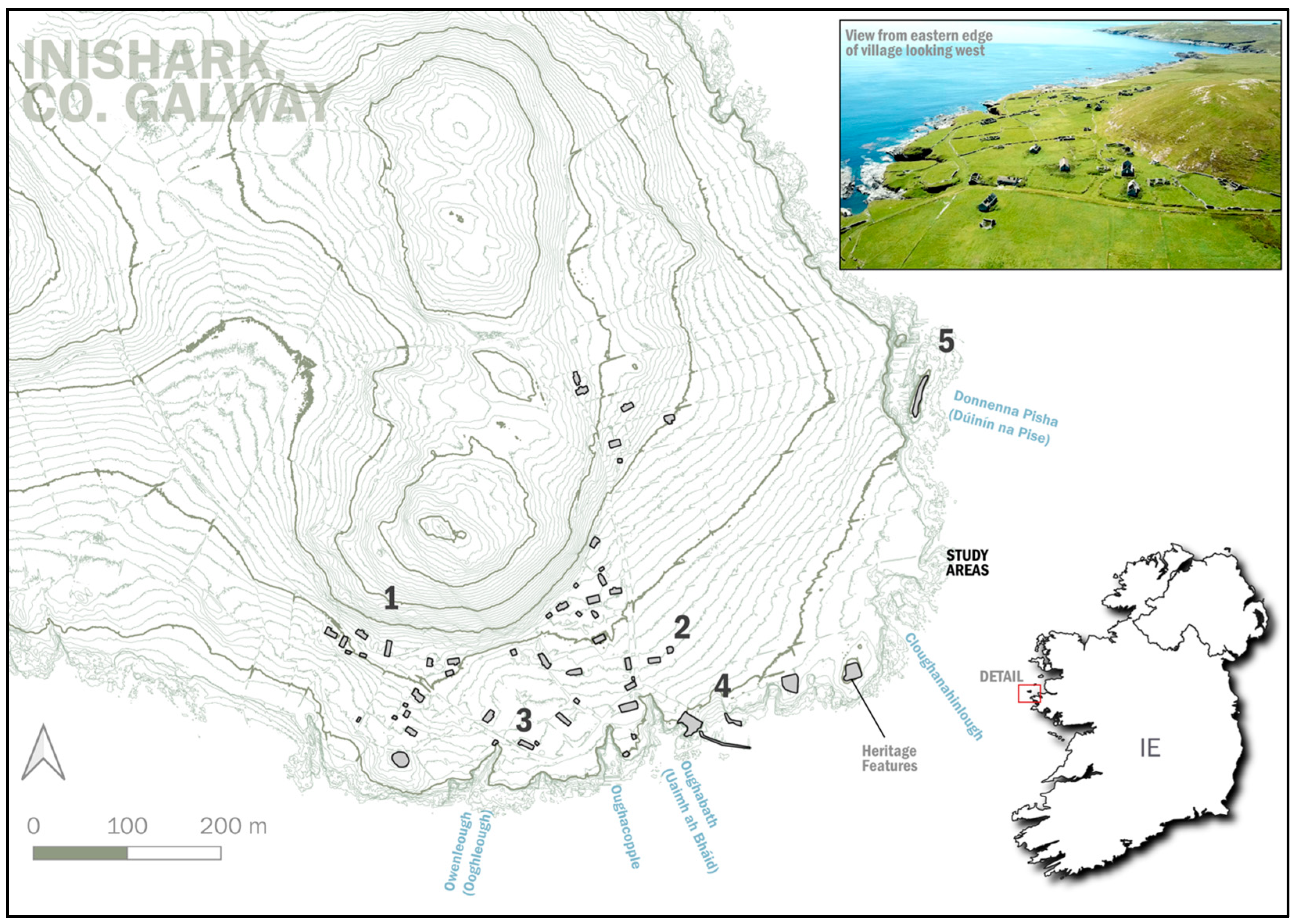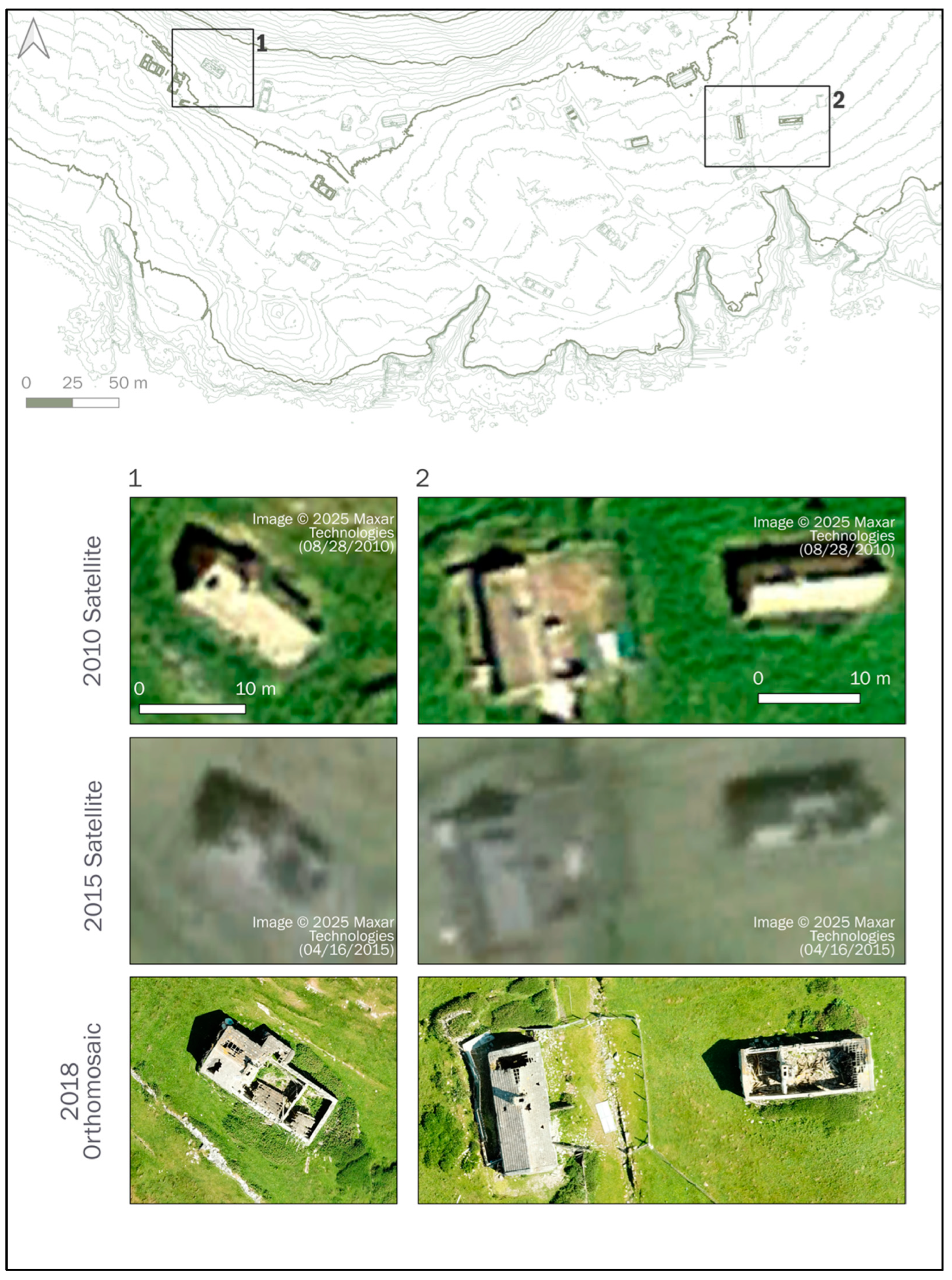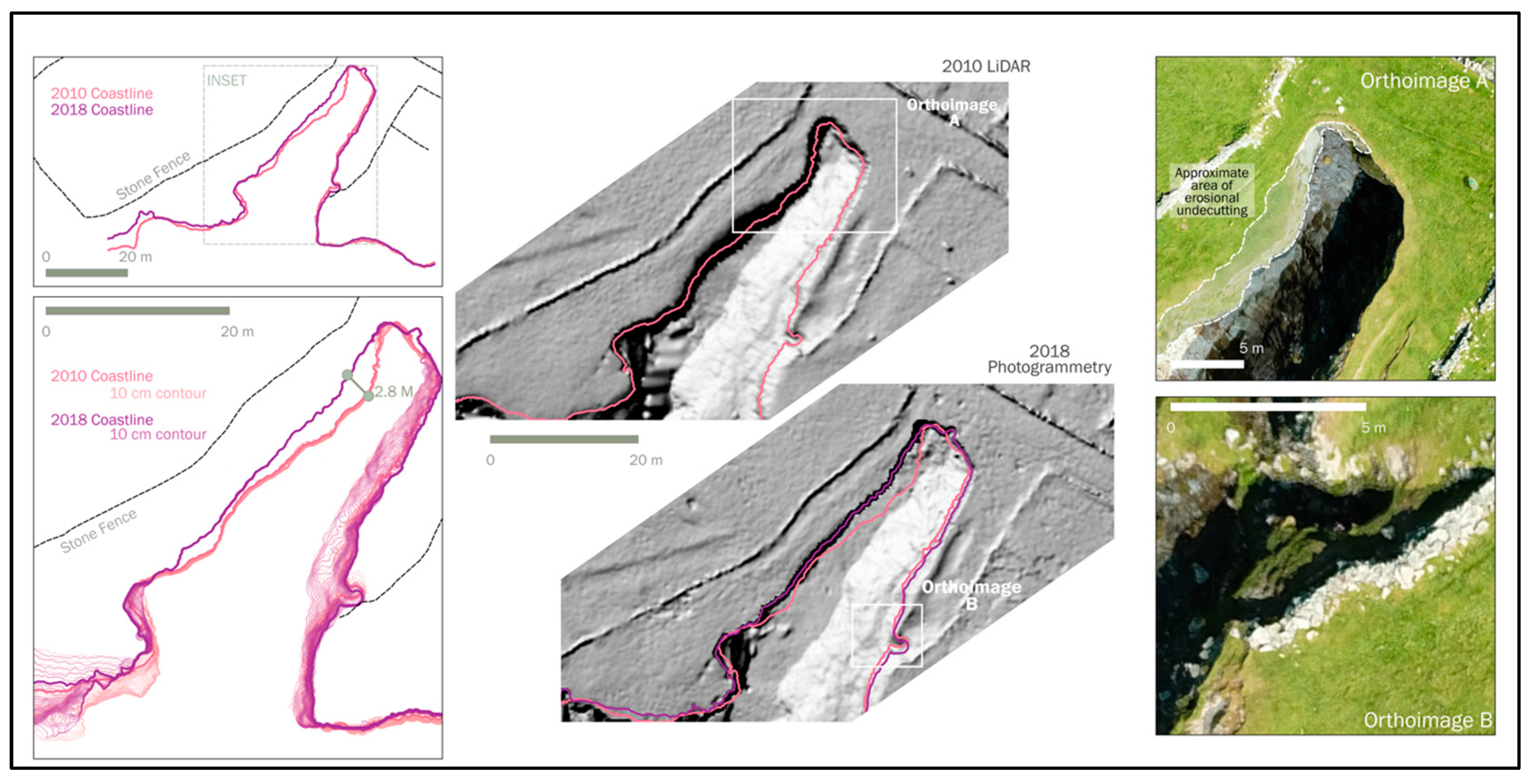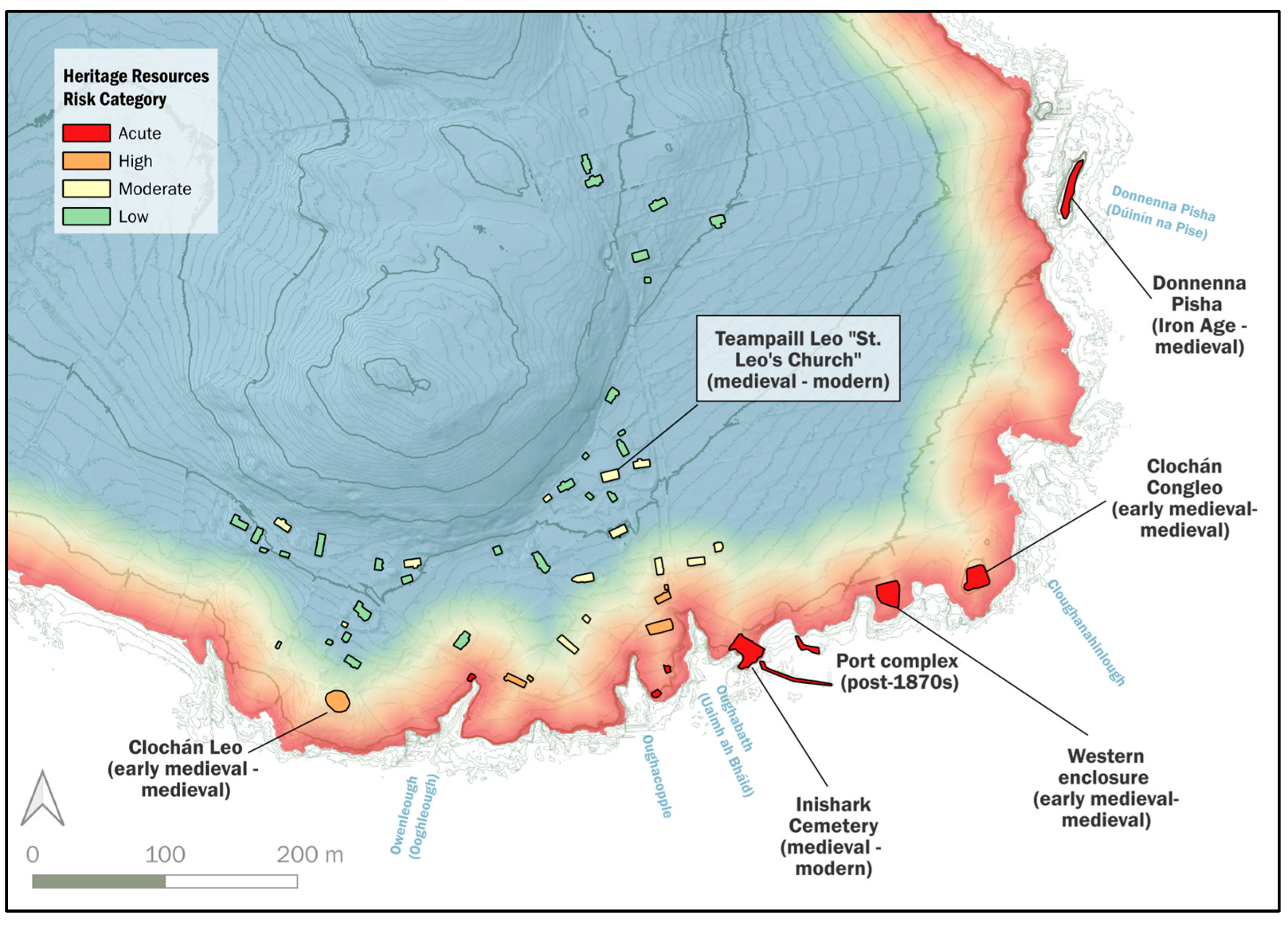Monitoring Irish Coastal Heritage Destruction: A Case Study from Inishark, Co. Galway, Ireland
Abstract
1. Introduction: Coastal Erosion and Remote Sensing as a Cultural Heritage Management Tool
2. Materials and Methods
3. Results: Significant Shoreline Retreat and Structural Loss Since the 1920s
3.1. Study Area #1 and #2
3.2. Study Area #3: Owenleough, a 60 m Long Inlet, South Side of Inishark
3.3. Study Area #4: Oughabath Inlet and the Inishark Cemetery
3.4. Study Area #5: Donnenna Pisha (Promontory Fort)
4. Discussion: The Importance of Integrated Remote Sensing in Proactive Heritage Management
5. Conclusions
Author Contributions
Funding
Data Availability Statement
Acknowledgments
Conflicts of Interest
References
- Daire, M.-Y.; Lopez-Romero, E.; Proust, J.-N.; Regnauld, H.; Pian, S.; Shi, B. Coastal Changes and Cultural Heritage (1): Assessment of the Vulnerability of the Coastal heritage in Western France. J. Isl. Coast. Archaeol. 2012, 7, 168–182. [Google Scholar] [CrossRef]
- Erlandson, J.M. As the world warms: Rising seas, coastal archaeology, and the erosion of maritime history. J. Coast. Conserv. 2012, 16, 137–142. [Google Scholar] [CrossRef]
- Fitzpatrick, S.M.; Kappers, M.; Kaye, Q. Coastal Erosion and Site Destruction on Carriacou, West Indies. J. Field Archaeol. 2006, 31, 251–262. [Google Scholar] [CrossRef]
- Reimann, L.; Vafeidis, A.T.; Brown, S.; Hinkel, J.; Tol, R.S.J. Mediterranean UNESCO World Heritage at risk from coastal flooding and erosion due to sea-level rise. Nat. Commun. 2018, 9, 4161. [Google Scholar] [CrossRef] [PubMed]
- Sanchez, F.G.; Sanchez, H.G.; Ribalaygua, C. Cultural heritage and sea level rise threat: Risk assessment of coastal fortifications in the Canary Islands. J. Cult. Herit. 2020, 44, 211–217. [Google Scholar] [CrossRef]
- Ackland, K.; Griffiths, H.; Barker, L.; Davies, S.; Driver, T.; Hunt, D. Mapping the impacts of coastal erosion on the heritage assets of Ynys Enlli (Bardsey Island), North Wales, UK. J. Isl. Coast. Archaeol. 2024, 19, 786–813. [Google Scholar] [CrossRef]
- Graham, E. Drone Survey to Monitor Erosion Impacts on Coastal Archaeological Sites. J. Field Archaeol. 2025, 50, 22–41. [Google Scholar] [CrossRef]
- Westley, K. Refining broad-scale vulnerability assessment of coastal archaeological resources, Lough Foyle, Northern Ireland. J. Isl. Coast. Archaeol. 2019, 14, 226–246. [Google Scholar] [CrossRef]
- Lipe, W.D. Archaeological values and resource management. In Archaeology and Cultural Resource Management: Visions for the Future; School for Advanced Research Press: Santa Fe, NM, USA, 2009; pp. 41–63. [Google Scholar]
- Surovell, T.A.; Toohey, J.L.; Myers, A.D.; LaBelle, J.M.; Ahern, J.C.; Reisig, B. The end of archaeological discovery. Am. Antiq. 2017, 82, 288–300. [Google Scholar] [CrossRef]
- Casana, J. Rethinking the Landscape: Emerging Approaches to Archaeological Remote Sensing. Ann. Rev. Anthropol. 2021, 50, 167–186. [Google Scholar] [CrossRef]
- Dimitris, K. Aerial Remote Sensing Archaeology-A Short Review of Application. Land 2024, 13, 997. [Google Scholar]
- Smith, R. Disasters and Archaeology: A Remote Sensing Approach for Determination of Archaeology At-Risk to Desertification in Sistan. Remote Sens. 2024, 16, 2382. [Google Scholar] [CrossRef]
- Argyrou, A.; Agapiou, A. A review of artificial intelligence and remote sensing for archaeological research. Remote Sens. 2022, 14, 6000. [Google Scholar] [CrossRef]
- Laugier, E.J.; Casana, J. Integrating satellite, UAV, and ground-based remote sensing in archaeology: An exploration of pre-modern land use in Northeastern Iraq. Remote Sens. 2021, 13, 5119. [Google Scholar] [CrossRef]
- Sakai, M.; Sakurai, A.; Lu, S.; Olano, J.; Albrecht, C.M.; Hamann, H.F.; Freitag, M. AI-accelerated Nazca survey nearly doubles the number of known figurative geoglyphs and sheds light on their purpose. Proc. Natl. Acad. Sci. USA 2024, 121, e2407652121. [Google Scholar] [CrossRef]
- Soroush, M.; Mehrtash, A.; Khazraee, E.; Ur, J.A. Deep learning in archaeological remote sensing: Automated qanat detection in the Kurdistan region of Iraq. Remote Sens. 2020, 12, 500. [Google Scholar] [CrossRef]
- Stewart, C.; Labrèche, G.; González, D.L. A pilot study on remote sensing and citizen science for archaeological prospection. Remote Sens. 2020, 12, 2795. [Google Scholar] [CrossRef]
- Kuijt, I.; Conway, M.; Shakour, K.; McNeill, C.; Brown, C. Vectors of improvement: The material footprint of nineteenth-through twentieth-century Irish National Policy, Inishark, county Galway, Ireland. Int. J. Hist. Archaeol. 2015, 19, 122–158. [Google Scholar] [CrossRef]
- Matthews, T.; Murphy, C.; Wilby, R.L.; Harrigan, S. Stormiest winter on record for Ireland and UK. Nat. Clim. Change 2014, 4, 738–740. [Google Scholar] [CrossRef]
- Herndon, K.E.; Griffin, R.; Schroder, W.; Murtha, T.; Golden, C.; Contreras, D.A.; Cherrington, E.; Wnag, L.; Bazarsky, A.; Van Kollias, G.; et al. Google Earth Engine for archaeologists: An updated look at the progress and promise of remotely sensed big data. J. Arhcaeol. Sci. Rep. 2023, 50, 104094. [Google Scholar] [CrossRef]
- Thuestad, A.E.; Risbol, O.; Kleppe, J.I.; Barlindhaug, S.; Myrvoll, E.R. Archaeological Surveying of Subarctic Landscapes: Comparing the Performance of Airborne Lader Scanning and Remote Sensing Image Data. Sustainability 2021, 13, 1917. [Google Scholar] [CrossRef]
- Maxar Intelligence & Maxar Space Systems. Available online: https://www.maxar.com/ (accessed on 1 January 2025).
- Gorelick, N.; Hancher, M.; Dixon, M.; Ilyushchenko, S.; Thau, D.; Moore, R. Google Earth Engine: Planetary-scale geospatial analysis for everyone. Remote Sens. Environ. 2017, 202, 18–27. [Google Scholar] [CrossRef]
- Rotheram, W.H. Ordnance Survey of Ireland, Galway, Sheet 9D & 9C. Ordnance Six-Inch Ireland, 1829–1969. The National Library of Scotland. 1989. Available online: https://maps.nls.uk/view/247668760 (accessed on 3 February 2025).
- Hesse, R. Possibilities and challenges in the application of mutli-temporal airborne lidar data sets for the monitoring of archaeological landscapes. In Proceedings of the 20th International Conference on Cultural Heritage and New Technologies, Vienna, Austria, 2–4 November 2015. [Google Scholar]
- Kaiser, T.; Clemen, C.; Maas, H.-G. Automatic co-registration of photogrammetric point clouds with digital building models. Autom. Constr. 2022, 134, 104098. [Google Scholar] [CrossRef]
- Shao, J.; Zhang, W.; Mellado, N.; Grussenmeyer, P.; Li, R.; Chen, Y.; Wan, P.; Zhang, X.; Cai, S. Automated markerless registration of point clouds from TLS and structured light scanner for heritage documentation. J. Cult. Herit. 2019, 35, 16–24. [Google Scholar] [CrossRef]
- Morelli, L.; Perda, G.; Ioli, F.; Trybala, P.; Sterpin, A.; Rigon, S.; Sutherland, N.; Medici, M.; Remondino, F.; Vitti, A. Co-registering Laser Scanning Point Clouds and Photogrammetric Images with Deep Learning Multi-Modal Matching. Int. Arch. Photogramm. Remote Sens. Spat. Inf. Sci. 2024, 48, 335–342. [Google Scholar] [CrossRef]
- QGIS.org. QGIS v3.28. QGIS Geographic Information System. QGIS Association. 2025. Available online: http://www.qgis.org (accessed on 1 January 2025).
- Mac Gabhann, F. Logainmneacha Mhaigh Eo 2. Barúntacht Mhuraisce; Coiscéim: Dublin, Ireland, 2014. [Google Scholar]
- Lash, R.; Kuijt, I.; Alonzi, E.; Chesson, M.; Burke, T. “Differing in Status, but One in Spirit”: Sacred Space and Social Diversity at Island Monasteries in Connemara, Ireland. Antiquity 2018, 92, 437–455. [Google Scholar] [CrossRef]
- Lash, R. Curation and Creativity: Devotional Heritage on Inishark and Inishbofin. In Sacred Realms and Folk Domains of Irish Holy Wells; Ray, C., Ed.; Indiana University Press: Bloomington, Indiana, 2023; pp. 264–275. [Google Scholar]
- MacLoughlin, B. Material Concerning the Surviving Antiquities of Inish Airc (Inishark). In Irish Folklore Collection; Irish Folklore Collection at University College Dublin: Dublin, Ireland, 1942; Volume 838–839. [Google Scholar]
- Jarmalavicius, D.; Smatas, V.; Stankunavicius, G.; Pupienis, D.; Zilinskas, G. Factors Controlling Coastal Erosion During Storm Events. J. Coast. Res. 2016, 75, 1112–1116. [Google Scholar] [CrossRef]
- Larson, W.E.; Lindstrom, M.J.; Schumacher, T.E. The role of severe storms in soil erosion: A problem needing consideration. J. Soil Water Conserv. 1997, 52, 90–95. [Google Scholar] [CrossRef]
- O’Keeffe, T. Omey and the Sands of Time. Archaeol. Irel. 1994, 8, 14–17. [Google Scholar]
- O’Sullivan, J.; Carragáin, T.Ó. Inishmurray: Monks and Pilgrims in an Atlantic Landscape; Collins: Cork, Ireland, 2008. [Google Scholar]
- Scott, R.E. Social Identity in Early Medieval Ireland: A Bioarchaeology of the Early Christian Cemetery on Omey Island, Co. Galway. Ph.D. Dissertation, University of Pennsylvania, Philadelphia, PA, USA, 2006. [Google Scholar]
- O’Sullivan, A.; McCormick, F.; Kerr, T.R.; Harney, L. Early Medieval Ireland, AD 400–1100: The Evidence from Archaeological Excavations; Royal Irish Academy: Dublin, Ireland, 2014. [Google Scholar]
- Bennett, P.; Wilson, A.; Buzaian, A.; Kattenberg, A. The effects of recent storms on the exposed coastline of Tocra. Libyan Stud. 2004, 35, 113–122. [Google Scholar] [CrossRef]
- Eidshaug, J.S.; Bjerck, H.B.; Lohndal, T.; Risbøl, O. Words as Archaeological Objects: A Study of Marine Lifeways, Seascapes, and Coastal Environmental Knowledge in the Yagan-English Dictionary. Int. J. Hist. Archaeol. 2024, 28, 722–766. [Google Scholar] [CrossRef]
- Fatorić, S.; Seekamp, E. Are cultural heritage and resources threatened by climate change? A systematic literature review. Clim. Change 2017, 142, 227–254. [Google Scholar] [CrossRef]
- Ford, M. Shoreline changes interpreted from multi-temporal aerial photographs and high resolution satellite images: Wotje Atoll, Marshall Islands. Remote Sens. Environ. 2013, 135, 130–140. [Google Scholar] [CrossRef]
- Nicu, I.C.; Rubensdotter, L.; Stalsber, K.; Nau, E. Coastal Erosion of Arctic Cultural Heritage in Danger: A Case Study from Svalbard, Norway. Water 2021, 13, 784. [Google Scholar] [CrossRef]
- Sesana, E.; Gagnon, A.S.; Ciantelli, C.; Cassar, J.; Hughes, J.J. Climate change impacts on cultural heritage: A literature review. WIREs Clim. Change 2021, 12, e710. [Google Scholar] [CrossRef]
- Westley, K.; Nikolaus, J.; Emrage, A.; Flemming, N.; Cooper, A. The impact of coastal erosion on the archaeology of the Cyrenaican coast of Eastern Libya. PLoS ONE 2023, 18, e0283703. [Google Scholar] [CrossRef]
- Kabuth, A.K.; Kroon, A.; Pedersen, J.B. Multidecadal shoreline changes in Denmark. J. Coast. Res. 2014, 30, 714–728. [Google Scholar]
- Fernandez-Montblanc, T.; Del Rio, L.; Izquierdo, A.; Gracia, F.J.; Bethencourt, M.; Benaventer, J. Shipwrecks and man-made coastal structures as indicators of historical shoreline position. An interdisciplinary study in the Sancti Petri san spit (Bay of Cadiz, SW Spain). Mar. Geol. 2018, 395, 152–167. [Google Scholar]
- Martinez-Sanchez, A.; Gracia, F.J.; Alonso, C.; Mata, E.; Caporizzo, C. Reconstructing the historical shoreline evolution of the Northern Bay of Cadiz (SW Spain) from geomorphological and geoarchaeological data. J. Maps 2023, 19, 2206585. [Google Scholar] [CrossRef]
- Huisman, H.; Heeres, G.; Os, B.v.; Derickx, W.; Schoorl, J. Erosion and Errors: Testing the Use of Repeated LIDAR Analyses and Erosion Modelling for the Assessment and Prediction of Erosion of Archaeological Sites? Conserv. Manag. Archaeol. Sites 2016, 18, 205–216. [Google Scholar] [CrossRef]








| RMSE (cm) | Data Source | Average RMSE (cm) | ||||||||
| 1989 Map | 2010 LiDAR | 2010 Satellite | 2015 Satellite | 2018 Photogrammetry | 2019 Satellite | 2023 Satellite | ||||
| Data Source | 1989 map | - | 20.53 | 22.23 | 21.06 | 20.93 | 21.42 | - | 21.23 | |
| 2010 LiDAR | 20.53 | - | 9.67 | 8.73 | 5.97 | 7.99 | 12.01 | 10.82 | ||
| 2010 satellite | 22.23 | 9.67 | - | 8.40 | 6.90 | 8.97 | 12.68 | 11.47 | ||
| 2015 satellite | 21.06 | 8.73 | 8.40 | - | 7.94 | 6.59 | - | 10.54 | ||
| 2018 photogrammetry | 20.93 | 5.97 | 6.90 | 7.94 | - | 8.40 | - | 10.03 | ||
| 2019 satellite | 21.42 | 7.99 | 8.97 | 6.59 | 8.40 | - | 11.17 | 10.76 | ||
| 2023 satellite | - | 12.01 | 12.68 | - | - | 11.17 | - | 11.95 | ||
| Average Number of Points Used for RMSE Calculation | ||||||||||
| No. of Points used for RMSE Calculation | Data Source | 1989 map | - | 9 | 9 | 8 | 8 | 8 | - | 8.4 |
| 2010 LiDAR | 9 | - | 11 | 11 | 20 | 8 | 3 | 10.3 | ||
| 2010 satellite | 9 | 11 | - | 8 | 8 | 11 | 3 | 8.3 | ||
| 2015 satellite | 8 | 11 | 8 | - | 8 | 8 | - | 8.6 | ||
| 2018 photogrammetry | 8 | 20 | 8 | 8 | - | 8 | - | 10.4 | ||
| 2019 satellite | 8 | 8 | 11 | 8 | 8 | - | 3 | 7.7 | ||
| 2023 satellite | - | 3 | 3 | - | - | 3 | - | 3.0 | ||
| Date | Event | Storm Characteristics | Reference (Accessed on 21 March 2025) | ||||||
|---|---|---|---|---|---|---|---|---|---|
| Year | Day-Month | Location of Record | Wind Speed (Sustained—km/h) | Wind Speed (Gusts—km/h) | Significant Wave Height (m) | Individual Wave Height (m) | Wind Direction (Degree) | ||
| 2024 | 21-January | Violent Storm Isha | Off Donegal Coast (M4 buoy) | 87 | 122 | 10.9 | 16.7 | https://cli.fusio.net/cli/stormcenter/PDF/Isha.pdf | |
| 2022 | 18-February | Violent Storm Eunice | Off Donegal Coast (M4 buoy) | 58 | 79 | 6.6 | 11.3 | https://cli.fusio.net/cli/stormcenter/PDF/Eunice.pdf | |
| 2021 | 7-December | Violent Storm Barra | Off Donegal Coast (M4 buoy) | 72 | 104 | 10.4 | 16.7 | https://cli.fusio.net/cli/stormcenter/PDF/Barra.pdf | |
| 2020 | 19-August | Violent Storm Ellen | Mace Head station | 39 | 50 | 80 | https://cli.fusio.net/cli/stormcenter/PDF/Ellen.pdf | ||
| 2017 | 16-October | Violent Storm Ophelia | Mace Head station | 70 | 94 | 67.5 | https://www.met.ie/cms/assets/uploads/2023/08/OpheliaReport_v1.pdf | ||
| 2014 | 12-February | Hurricane-Force Storm Darwin | Mace Head station | 120 | 155 | https://www.met.ie/cms/assets/uploads/2017/08/2014StormDarwin-1.pdf | |||
| 2013/14 | Winter | Winter Storms | Mace Head station | 65 | 84 | 280 | https://www.met.ie/cms/assets/uploads/2017/08/WinterStorms13_14.pdf | ||
| 1998 | 26-December | Hurricane Force Winds over North and Northwest | https://www.met.ie/cms/assets/uploads/2017/08/Dec1998_Storm.pdf | ||||||
| 1997 | 24-December | Windstorm | https://www.met.ie/cms/assets/uploads/2017/08/Dec1997_storm.pdf | ||||||
| 1991 | 5-January | Windstorm | https://www.met.ie/cms/assets/uploads/2017/08/Jan1991_storm.pdf | ||||||
| 1990 | February | Storms and Heavy Rain | https://www.met.ie/cms/assets/uploads/2017/08/Feb1990_storms.pdf | ||||||
| 1988 | 9-February | Storm Force Winds Over Ireland | https://www.met.ie/cms/assets/uploads/2017/08/Feb1988_storm.pdf | ||||||
| 1986 | August | Storm—Hurricane Charley | https://www.met.ie/cms/assets/uploads/2017/08/Aug1986_HurCharlie.pdf | ||||||
| 1976 | 2-January | Storm | https://www.met.ie/cms/assets/uploads/2017/08/Jan1976_Storm.pdf | ||||||
| 1974 | 11 through 12-January | Severe storm caused widespread damage | https://www.met.ie/cms/assets/uploads/2017/08/Jan1974_Storm.pdf | ||||||
| 1961 | 16-September | Storm—Hurricane Debbie | https://www.met.ie/cms/assets/uploads/2017/08/Sep1961_hurricane-Debbie.pdf | ||||||
| 1927 | 28-October | Major Storm Off the West Coast | https://www.met.ie/cms/assets/uploads/2017/08/Oct1927_storm.pdf | ||||||
| 1903 | 18 through 27-February | Storm Causing Widespread Damage | https://www.met.ie/cms/assets/uploads/2017/08/Feb1903_storm.pdf | ||||||
| 1839 | 6 through 7-January | The Night of the Big Wind | https://www.met.ie/cms/assets/uploads/2017/08/Jan1839_Storm.pdf | ||||||
| Resource | Threat | Approximate Rate of Threat |
|---|---|---|
| Post-1910 structures | Roof collapse | 3–5.5 m2/year |
| Owenleough | Inlet erosion, horizontal shoreline shift | 0.15–0.35 m/year |
| Oughabath and Cemetary | Inlet erosion, horizontal shoreline shift and/or undercutting | 0.15–0.27 m/year |
| Donnenna Pisha | Islet erosion, areal loss | 3–5.75 m2/year |
Disclaimer/Publisher’s Note: The statements, opinions and data contained in all publications are solely those of the individual author(s) and contributor(s) and not of MDPI and/or the editor(s). MDPI and/or the editor(s) disclaim responsibility for any injury to people or property resulting from any ideas, methods, instructions or products referred to in the content. |
© 2025 by the authors. Licensee MDPI, Basel, Switzerland. This article is an open access article distributed under the terms and conditions of the Creative Commons Attribution (CC BY) license (https://creativecommons.org/licenses/by/4.0/).
Share and Cite
Field, S.; Kuijt, I.; Lash, R.; Burke, T. Monitoring Irish Coastal Heritage Destruction: A Case Study from Inishark, Co. Galway, Ireland. Remote Sens. 2025, 17, 2709. https://doi.org/10.3390/rs17152709
Field S, Kuijt I, Lash R, Burke T. Monitoring Irish Coastal Heritage Destruction: A Case Study from Inishark, Co. Galway, Ireland. Remote Sensing. 2025; 17(15):2709. https://doi.org/10.3390/rs17152709
Chicago/Turabian StyleField, Sean, Ian Kuijt, Ryan Lash, and Tommy Burke. 2025. "Monitoring Irish Coastal Heritage Destruction: A Case Study from Inishark, Co. Galway, Ireland" Remote Sensing 17, no. 15: 2709. https://doi.org/10.3390/rs17152709
APA StyleField, S., Kuijt, I., Lash, R., & Burke, T. (2025). Monitoring Irish Coastal Heritage Destruction: A Case Study from Inishark, Co. Galway, Ireland. Remote Sensing, 17(15), 2709. https://doi.org/10.3390/rs17152709







